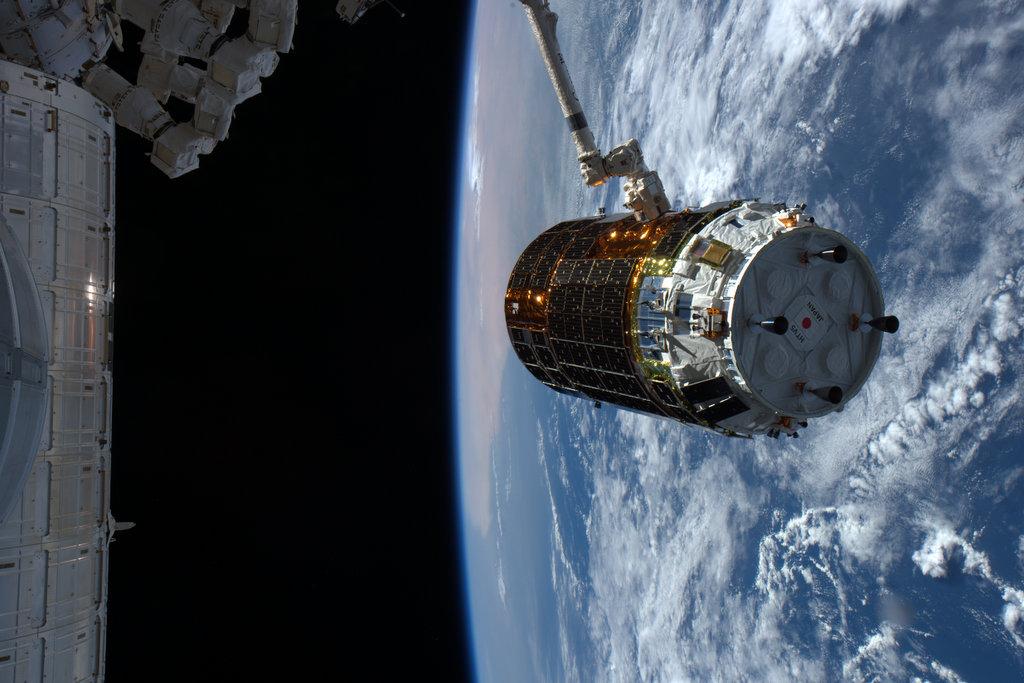Japanese Cargo Ship Delivers Mouse House, Booze and More to Space Station

A robotic Japanese cargo ship made a special delivery to the International Space Station on Sunday (Aug. 24), ending a four-day trek to ferry tons of food, supplies — and even a mouse habitat and (experimental) liquor — to the orbiting lab.
The H-II Transfer Vehicle, called HTV-5, arrived at the space station at 6:55 a.m. EDT (1055 GMT), when it was captured via a robotic arm by astronauts inside the space station. The Japan Aerospace Exploration Agency (JAXA) launched the HTV-5 cargo ship on Wednesday (Aug. 19).
"HTV-5 capture was successful!" wrote space station astronaut Kimiya Yui of Japan, who piloted the robotic arm along with NASA astronaut Kjell Lindgren, on Twitter after grappling the spacecraft. "Thank you all for your support and hard work." [Japan's HTV Spaceship Fleet in Pictures]
After Yui and Lindgren's capture of the HTV-5 spacecraft, flight controllers at NASA's Mission Control Center in Houston were expected to use the station's robotic arm to remotely park the cargo ship at an available docking port.
JAXA's HTV spacecraft are known in Japan as Kounotori, which is Japanese for "White Stork." The HTV-5 spacecraft is carrying about 9,500 lbs. (4,309 kilograms) of supplies and science gear for the space station crew.
That cargo haul includes:
- A small cache of whiskey, tequila and Midori, which are being sent to see how microgravity affects the "mellowness" of their tastes after one or two years in space. The experiment was developed by the Tokyo-based Suntory Global Innovation Center.
- Habitats for 12 mice, which are part of an experiment studying the effects of weightlessness during long space missions. Mice will be housed in compartments that can switch between microgravity and Earth gravity as part of that study.
- Equipment for NASA's twins study, which is tracking Scott Kelly on the space station and his identical twin brother, Mark Kelly, on Earth. Scott is currently spending a full year on the International Space Station, while Mark, as the control subject, remains on Earth. Russian cosmonaut Mikhail Kornienko is also spending a year on the station with Scott as part of that extreme-duration flight.
- A new CALorimetric Electron Telescope delivered by HTV-5 will seek dark matter and examine cosmic rays from the space station, away from the distorting effect of Earth's atmosphere. With the telescope's high-resolution data, researchers will learn more about the makeup of the galaxy and the risks cosmic rays pose to astronauts.
- A variety of small satellites, including 14 Earth-watching Dove cubesat satellites, which will be used for Earth observation. Other cubesats include a trio built to test communications systems for global aircraft tracking and the student-built AAUSAT5, designed to test ship beacon signal technology.
- A new NanoRacks External Platform(NREP) to be attached on the porchlike external facility of the Japanese Kibo module. The NREP is designed to serve as a sort of base for future experiments sent to the station.
Like its name suggests, HTV-5 is the fifth Japanese HTV spacecraft to ferry supplies to the space station. These spacecraft are cylindrical vehicles that measure 33 feet (10 meters) long and 13 feet (4 m) wide. HTV spacecraft are also disposable: Once the HTV-5 mission is complete, the vehicle will be detached from the station and travel to burn up in Earth's atmosphere.
Get the Space.com Newsletter
Breaking space news, the latest updates on rocket launches, skywatching events and more!
Japan's HTV spacecraft are part of an international fleet of robotic cargo ships serving the astronauts on the International Space Station. Russia launches unmanned Progress cargo ships to the space station, with NASA contracting resupply services to the private companies SpaceX and Orbital ATK. The European Space Agency has also provided five cargo missions using its huge Automated Transfer Vehicle.
The space station is currently home to six astronauts, representing the United States, Russia and Japan.
Editor's note: This story was updated on Aug. 25 to correct the fact that mouse habitats, and not actual mice, were launched to the International Space Station on HTV-5.
Email Sarah Lewin at slewin@space.com or follow her @SarahExplains. Follow us @Spacedotcom, Facebook and Google+. Original article on Space.com.
Join our Space Forums to keep talking space on the latest missions, night sky and more! And if you have a news tip, correction or comment, let us know at: community@space.com.

Sarah Lewin started writing for Space.com in June of 2015 as a Staff Writer and became Associate Editor in 2019 . Her work has been featured by Scientific American, IEEE Spectrum, Quanta Magazine, Wired, The Scientist, Science Friday and WGBH's Inside NOVA. Sarah has an MA from NYU's Science, Health and Environmental Reporting Program and an AB in mathematics from Brown University. When not writing, reading or thinking about space, Sarah enjoys musical theatre and mathematical papercraft. She is currently Assistant News Editor at Scientific American. You can follow her on Twitter @SarahExplains.









